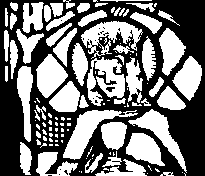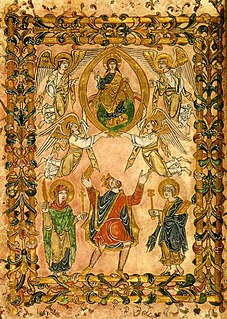
Eadwig was King of England from 23 November 955 until his death in 959. He was the elder son of Edmund I and his first wife Ælfgifu, who died in 944. Eadwig and his brother Edgar were young children when their father was killed trying to rescue his seneschal from attack by an outlawed thief on 26 May 946. As Edmund's sons were too young to rule he was succeeded by his brother Eadred, who suffered from ill health and died unmarried in his early 30s.

Edward, often called the Martyr, was King of the English from 975 until he was murdered in 978. Edward was the eldest son of King Edgar, but was not his father's acknowledged heir. On Edgar's death, the leadership of England was contested, with some supporting Edward's claim to be king and others supporting his younger half-brother Æthelred the Unready, recognised as a legitimate son of Edgar. Edward was chosen as king and was crowned by his main clerical supporters, the archbishops Dunstan of Canterbury and Oswald of York.

Edgar, known as the Peaceful or the Peaceable, was King of the English from 959 until his death in 975. The younger son of King Edmund I and Ælfgifu of Shaftesbury, he came to the throne as a teenager following the death of his older brother, King Eadwig. As king, Edgar further consolidated the political unity achieved by his predecessors, with his reign being noted for its relative stability. His most trusted advisor was Dunstan, whom he recalled from exile and made Archbishop of Canterbury. The pinnacle of Edgar's reign was his coronation at Bath in 973, which was organised by Dunstan and forms the basis for the current coronation ceremony. After his death he was succeeded by his son Edward, although the succession was disputed.

Eadred was King of the English from 26 May 946 until his death. He was the younger son of Edward the Elder and his third wife Eadgifu, and a grandson of Alfred the Great. His elder brother, Edmund, was killed trying to protect his seneschal from an attack by a violent thief. Edmund's two sons, Eadwig and Edgar, were then young children, so Eadred became king. He suffered from ill health in the last years of his life and he died at the age of a little over thirty, having never married. He was succeeded successively by his nephews, Eadwig and Edgar.

Pershore Abbey, at Pershore in Worcestershire, was an Anglo-Saxon abbey and is now an Anglican parish church, the Church of the Holy Cross.

Eadburh was the daughter of King Edward the Elder of England and his third wife, Eadgifu of Kent. She lived most of her life as a nun known for her singing ability. Most of the information about her comes from hagiographies written several centuries after her life. She was canonised twelve years after her death and there are a small number of churches dedicated to her, most of which are located near Worcestershire, where she lived.

Ealhswith or Ealswitha was the wife of King Alfred the Great. Her father was a Mercian nobleman, Æthelred Mucel, Ealdorman of the Gaini, which is thought to be an old Mercian tribal group. Her mother was Eadburh, a member of the Mercian royal family. Ealhswith is commemorated as a saint in the Christian East and the West on 20 July.
Ælfthryth was Queen of the English from her marriage to King Edgar in 964 or 965 until Edgar's death in 975. Ælfthryth was the first wife of an English king known to have been crowned and anointed as queen. She had two sons with Edgar, the ætheling Edmund and King Æthelred the Unready. Ælfthryth was a powerful political figure and possibly orchestrated the murder of her stepson, King Edward the Martyr, in order to place her son Æthelred on the throne. She appeared as a stereotypical bad queen and evil stepmother in many medieval histories.
Saint Grimbald was a 9th-century Benedictine monk at the Abbey of Saint Bertin near Saint-Omer, France.

Æthelwold of Winchester was Bishop of Winchester from 963 to 984 and one of the leaders of the tenth-century monastic reform movement in Anglo-Saxon England.

The Old Minster was the Anglo-Saxon cathedral for the diocese of Wessex and then Winchester from 660 to 1093. It stood on a site immediately north of and partially beneath its successor, Winchester Cathedral.

Herbert de Losinga was the first Bishop of Norwich. He founded Norwich Cathedral in 1096 when he was Bishop of Thetford.

Hyde Abbey was a medieval Benedictine monastery just outside the walls of Winchester, Hampshire, England. It was dissolved and demolished in 1538 following various acts passed under King Henry VIII to dissolve monasteries and abbeys. The Abbey was once known to have housed the remains of King Alfred the Great, his son, King Edward the Elder, and his wife, Ealswitha. Following its dissolution these remains were lost, however excavations of the Abbey and the surrounding area continue.

Edward the Elder was King of the Anglo-Saxons from 899 until his death in 924. He was the elder son of Alfred the Great and his wife Ealhswith. When Edward succeeded to the throne, he had to defeat a challenge from his cousin Æthelwold, who had a strong claim to the throne as the son of Alfred's elder brother and predecessor, Æthelred I.
Events from the 10th century in the Kingdom of England.
St. Mary's Abbey, also known as the Nunnaminster, was a Benedictine nunnery in Winchester, Hampshire, England. It was founded between 899 and 902 by Alfred the Great's widow Ealhswith, who was described as the 'builder' of the Nunnaminster in the New Minster Liber Vitae. The first buildings were completed by their son, Edward the Elder. Among the house's early members was Edward's daughter Edburga.
Ælfgifu of Shaftesbury was the first wife of King Edmund I. She was Queen of the English from her marriage in around 939 until her death in 944. Ælfgifu and Edmund were the parents of two future English kings, Eadwig and Edgar. Like her mother Wynflaed, Ælfgifu had a close and special if unknown connection with the royal nunnery of Shaftesbury (Dorset), founded by King Alfred, where she was buried and soon revered as a saint. According to a pre-Conquest tradition from Winchester, her feast day is 18 May.

The English Benedictine Reform or Monastic Reform of the English church in the late tenth century was a religious and intellectual movement in the later Anglo-Saxon period. In the mid-tenth century almost all monasteries were staffed by secular clergy, who were often married. The reformers sought to replace them with celibate contemplative monks following the Rule of Saint Benedict. The movement was inspired by Continental monastic reforms, and the leading figures were Dunstan, Archbishop of Canterbury, Æthelwold, Bishop of Winchester, and Oswald, Archbishop of York.

The New Minster Charter is an Anglo-Saxon illuminated manuscript that was likely composed by Bishop Æthelwold and presented to the New Minster in Winchester by King Edgar in the year 966 AD to commemorate the Benedictine Reform. It is now part of the British Library's collection.













